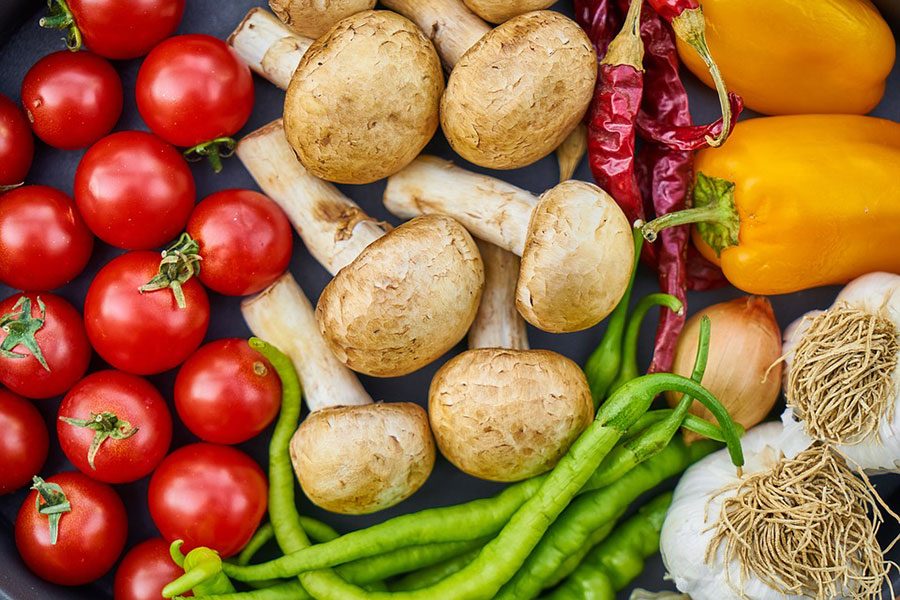Eating for the Earth
MaxPixel’s contributors
Vegetables play a big role in the planetary health diet, similarly to vegetarian or vegan diets. Though the planetary health diet leaves some room for meat, eggs and dairy, North Americans on average will need to decrease their beef/pork intake by 84%, egg intake by 63%, chicken intake by 57% and dairy intake by 31% in order to fit the diet according to the EAT-Lancet report. Foods like legumes, fruits and vegetables would be taking the place of the animal products we’d be eating less of.
May 10, 2019
Every so often, a new diet comes into the eyes of those in nutrition and health communities. Many people are familiar with vegetarianism, veganism or keto (high protein, low carb) and paleo (all unprocessed food) diets. But what about the planetary health diet? Created by the EAT-Lancet commission group, this diet combines health goals for both the individual and the Earth by targeting sustainable foods and lowering added sugars, meat, and saturated fats.
The EAT-Lancet report lists the specific amounts of each food type, by mass, to fit the goals of the diet, with ranges of each food type added to accommodate differing daily calorie intakes.
One of the most prominent parts of this diet is the reduction of meat and dairy product consumption. Plant-based protein options are much more energy efficient than their animal-based counterparts. “Eating plants is a more direct source of energy because, in order to raise livestock that’s turned into meat for us to eat, they also need to be fed,” said Camille Carson, an Environmental Science and Biology teacher at HBHS. “You get more energy from eating plants than from eating animals because you skip the middleman.”
When done right, this diet can bring lots of individual health benefits. “A lot of trans fat and saturated fat, basically any fat that is firm or gelatinous at room temperature, tends to be bad for you, and a lot of meat from animals falls into that category,” said Tess Crooks ‘19, who generally follows a vegetarian diet in order to help the environment. The reduction of meat intake with this diet, among other changes such as reduced added sugar and processed foods, promotes increased personal health.
When following the planetary health diet, though, improved physical health isn’t guaranteed. The EAT-Lancet diet leaves lots of room for corn and soy, which, like most things, can be unhealthy in large quantities. “There’s a bitter aftertaste of the 20th-century government-recommended diets high in carbohydrates and low in fat, which are now considered a factor in skyrocketing obesity and Type 2 diabetes,” said Faye Flam in an article for Bloomberg. Just like any other diet, with or without meat or dairy, following the guidelines isn’t enough to improve physical health; getting a wide variety of nutrients and eating a balanced diet in terms of carbs, fats, protein and fiber is needed to keep our bodies running.
Globally, making the switch to the EAT-Lancet diet would be difficult, as it may work against the average diets of local people. In North America, diets often include much more meat and dairy than the EAT-Lancet report suggests and, despite all the positives associated with reducing animal products in our food, many are reluctant to give up the foods they love. “People really like their steaks and chicken tenders,” said Carson. “I don’t know if [a mostly plant-based diet across the world] would happen.”
The EAT-Lancet report also doesn’t really consider the cultural aspects of food. Putting a global limit on meat and dairy consumption and replacing it with different, perhaps non-native or non-traditional, plant proteins and vegetables may add reluctance to upholding this diet. By creating one diet for everyone across the globe, this diet would be “attempting to unravel years and years of recipes, stories, and histories that food embodies,” according to Harry Harris in an article for NewStatesman. Forcing people across the globe to give up their traditional recipes in the name of a better environment may prove to be very difficult.
An Earth-friendly diet isn’t always affordable, either. Eating the best quality foods with the fewest amounts of added sugars, fats, or chemicals often comes along with a higher price tag. Even the simple essentials such as bread can cost three of four times more than their more processed alternatives when eating with this diet. Sam Bloch, a writer who tried following this diet as strictly as suggested, documented the prices and recipes which he used for Yes! Magazine. He reported that food for two had cost about $159.54 a week, translating to approximately $3988.50 per person per year. This $3988.50 estimate is based in New York City, where food prices are higher than the average across the US, but it’s still almost $900 above the average food budget for the city according to Nick Wallace in an article for SmartAsset. These extra expenses may be affordable to some, but a complete adherence to this diet by everyone across the globe wouldn’t be reasonable price-wise with the current options available now.
It’s also nearly impossible to eat out with the restrictions of the planetary health diet. Since food ordered from a restaurant often doesn’t disclose (or even measure) the exact amounts of every single ingredient in a certain dish, making your own food is often times the only way to control all of the ingredients and nutrients going into a meal. Putting together lunches can be time-consuming and difficult for anyone who isn’t particularly skilled or interested in cooking.
One aspect of sustainable dieting that the report didn’t add is the prospect of cultured meat. After harmlessly scratching off a few muscle cells from a cow and putting those cells into a lab to grow, it takes about two years to create enough meat for a burger patty. Though this process seems long, one cow is able to produce 175 million burger patties, a feat which would normally need thousands of cows according to Maastricht University. This process isn’t perfected for large-scale production yet, but it is a promising solution to the harmful system we currently have since it’s much more Earth-friendly.
Despite the flaws of this proposed planetary health diet, the main ideas behind it still hold true: our agricultural system as it stands now, particularly in the US and North America, is not sustainable. In order to feed the Earth’s rising population and keep our environment intact in the process, our diets won’t be able to stay the same as they are now. Though a complete adherence to the planetary health diet may not be attainable for you, occasionally swapping meat, dairy or sugar-heavy choices with fruits, vegetables, nuts and legumes is a good first step.














